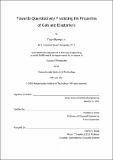| dc.contributor.advisor | Bradley D. Olsen. | en_US |
| dc.contributor.author | Lin, Tzyy-Shyang. | en_US |
| dc.contributor.other | Massachusetts Institute of Technology. Department of Chemical Engineering. | en_US |
| dc.date.accessioned | 2021-05-24T19:39:31Z | |
| dc.date.available | 2021-05-24T19:39:31Z | |
| dc.date.copyright | 2020 | en_US |
| dc.date.issued | 2021 | en_US |
| dc.identifier.uri | https://hdl.handle.net/1721.1/130659 | |
| dc.description | Thesis: Ph. D., Massachusetts Institute of Technology, Department of Chemical Engineering, February, 2021 | en_US |
| dc.description | Cataloged from the official PDF of thesis. "February 2021." | en_US |
| dc.description | Includes bibliographical references. | en_US |
| dc.description.abstract | Polymer networks are critical to modern society. Applications of polymer networks, in the form of gels and elastomers, provide essential support for everyday life. However, while many aspects of the physics of polymer networks have been established in the past few decades, most theoretical efforts have been centered around the study of model polymer networks with highly regular topology. While this framework has provided important insights into the physics of polymer networks, the neglection of variation in network topology can significantly undermine the predictive power of existing classical theories. To provide accurate predictions, the role of network topology must be considered. Therefore, this thesis investigates the impact of topological defects on the properties of polymer networks. The first part of this thesis focuses on the topology of end-linked networks and the formation of defects. | en_US |
| dc.description.abstract | Herein, rate theories and kinetic Monte Carlo simulations are used to simulate the gelation of multi-arm macromonomers. It is shown that even with precursor geometries that eliminate the formation of primary loops, polymer networks still invariably possess higher order cyclic defects. Furthermore, it is found that the cyclic topologies of A[subscript f]+B[subscript f] networks are characterized by the same universal function that determines the cyclic topologies of A₂+B[subscript f] networks. The second part of this thesis focuses on quantifying the impacts of topological defects on the mechanical properties of polymer networks. Starting with revisiting the assumptions of classical linear elasticity theories, closed-form expressions for the effects of dangling ends and isolated loops are derived under the context of phantom network theory. Notably, it is found that in the infinite dilution limit, all loops of order three or larger do not exhibit any net impact on elasticity. | en_US |
| dc.description.abstract | In addition, a comparison to experimental data reveals that the conformation of network strands may be more contracted than commonly perceived, motivating revisits to classical assumptions. Furthermore, by going beyond the mean-field approximation, new network theories that provide predictions for systems containing large fractions of defects are also presented. Beyond linear mechanics, underlying assumptions of the fracture theory of Lake and Thomas have also been revisited. It is shown that by revising their central assumption of sharp crack planes, tearing energy data of loopy networks can be quantitatively explained, thereby providing insights into the molecular details of fracture mechanics. The final part of this thesis investigates the effects of looping reactions on sol-gel transition. It is found that a purely topological kinetic model can provide accurate predictions on the gel point suppression across many systems. | en_US |
| dc.description.abstract | Furthermore, studies on the critical exponents reveals that loopy networks do not always follow mean field percolation. Rather, a family of previously unreported criticality classes are discovered. This finding provides a potential reconciliation to existing data that are largely disparate. | en_US |
| dc.description.statementofresponsibility | by Tzyy-Shyang Lin. | en_US |
| dc.format.extent | 272 pages | en_US |
| dc.language.iso | eng | en_US |
| dc.publisher | Massachusetts Institute of Technology | en_US |
| dc.rights | MIT theses may be protected by copyright. Please reuse MIT thesis content according to the MIT Libraries Permissions Policy, which is available through the URL provided. | en_US |
| dc.rights.uri | http://dspace.mit.edu/handle/1721.1/7582 | en_US |
| dc.subject | Chemical Engineering. | en_US |
| dc.title | Towards quantitatively predicting the properties of gels and elastomers | en_US |
| dc.type | Thesis | en_US |
| dc.description.degree | Ph. D. | en_US |
| dc.contributor.department | Massachusetts Institute of Technology. Department of Chemical Engineering | en_US |
| dc.identifier.oclc | 1251766994 | en_US |
| dc.description.collection | Ph.D. Massachusetts Institute of Technology, Department of Chemical Engineering | en_US |
| dspace.imported | 2021-05-24T19:39:31Z | en_US |
| mit.thesis.degree | Doctoral | en_US |
| mit.thesis.department | ChemEng | en_US |
